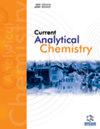Purification and Kinetics of Chlorogenic Acid from Eucommia ulmoides Oliver Leaves by Macroporous Resins Combined with First-Principles Calculation
IF 1.7
4区 化学
Q3 CHEMISTRY, ANALYTICAL
引用次数: 0
Abstract
Background: A simple and effective method to separate chlorogenic acid from Eucommia ulmoides leaves with macroporous resin was studied in this paper. Methods: In order to optimize the separation process of chlorogenic acid from Eucommia ulmoides leaves, dynamic adsorption and desorption experiments were carried out on a glass column filled with XDA-8 resin. Based on the First-principles calculation, the possible adsorption models were simulated. Results: Among the six macroporous resins, XDA-8 showed good adsorption/desorption capacity and a high adsorption/desorption ratio for chlorogenic acid. After being treated with XDA-8 resin once, the content of chlorogenic acid from the extraction increased by 525%, and the recovery of chlorogenic acid reached 85.36%. Conclusion: At 25°C, the adsorption behavior of chlorogenic acid on XDA-8 resin was consistent with the Langmuir isotherm model and pseudo-second-order kinetic model. Furthermore, by calculating the charge changes of the O atom at each position in the chlorogenic acid molecule and the H atom at the adsorption site in polystyrene molecule with resin skeleton, and combining with the electron cloud density distribution diagram of chlorogenic acid and resin skeleton, the adsorption of chlorogenic acid by XDA-8 resin is mainly due to the charge transfer, which causes the electron cloud to overlap.利用大孔树脂从杜仲叶中提纯绿原酸及其动力学研究与第一原理计算相结合
背景:本文研究了一种利用大孔树脂从杜仲叶中分离绿原酸的简单而有效的方法。方法:为了优化杜仲叶中绿原酸的分离过程,在填充有 XDA-8 树脂的玻璃柱上进行了动态吸附和解吸实验。在第一原理计算的基础上,模拟了可能的吸附模型。结果显示在六种大孔树脂中,XDA-8 对绿原酸具有良好的吸附/解吸能力和较高的吸附/解吸比。用 XDA-8 树脂处理一次后,提取物中的绿原酸含量增加了 525%,绿原酸回收率达到 85.36%。结论在 25℃条件下,绿原酸在 XDA-8 树脂上的吸附行为符合 Langmuir 等温线模型和假二阶动力学模型。此外,通过计算绿原酸分子中各位置 O 原子的电荷变化和树脂骨架聚苯乙烯分子中吸附位点 H 原子的电荷变化,并结合绿原酸和树脂骨架的电子云密度分布图,XDA-8 树脂对绿原酸的吸附主要是由于电荷转移导致电子云重叠。
本文章由计算机程序翻译,如有差异,请以英文原文为准。
求助全文
约1分钟内获得全文
求助全文
来源期刊

Current Analytical Chemistry
化学-分析化学
CiteScore
4.10
自引率
0.00%
发文量
90
审稿时长
9 months
期刊介绍:
Current Analytical Chemistry publishes full-length/mini reviews and original research articles on the most recent advances in analytical chemistry. All aspects of the field are represented, including analytical methodology, techniques, and instrumentation in both fundamental and applied research topics of interest to the broad readership of the journal. Current Analytical Chemistry strives to serve as an authoritative source of information in analytical chemistry and in related applications such as biochemical analysis, pharmaceutical research, quantitative biological imaging, novel sensors, and nanotechnology.
 求助内容:
求助内容: 应助结果提醒方式:
应助结果提醒方式:


